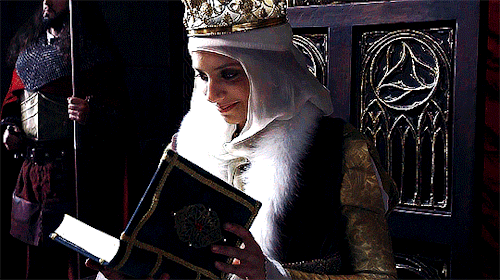latristereina:Once it became clear that she would, in fact, rule alongside Fernando, Isabel sought t
latristereina:Once it became clear that she would, in fact, rule alongside Fernando, Isabel sought to remedy the deficiencies of her own early education. Her approach was initially sporadic because of the demands made upon her by motherhood, war, and constant travel. In the course of fulfilling this myriad of responsibilities, she received practical training in diplomacy and statecraft. At the same time, she undertook the study of Latin so that she could “scan the texts of treaties and charters, and to read with pleasure the Vulgate and Caesar’s Commentaries—enough to be determined that her children should have what she (and Ferdinand) had missed” (Mattingly, Catherine of Aragon 17).As part of her own interest in Latin and as a means of encouraging imitation of her educational endeavors among the members of the court, the queen sponsored publication of a number of practical texts. Among these were Alonso de Palencia’s Universal Vocabulario en Latín y en romance [Universal Vocabulary in Latin and in Romance] and an interlinear edition of Antonio de Nebrija’s Introducciones latines [Introduction to Latin]. These works along with Nebrija’s Gramática castellana [Castilian Grammar] were especially aimed at instructing ladies of her court. Nebrija’s Grámatica established rules that facilitated the study of Castilian, while his Introducciones made possible private tutoring in Latin.From the education of herself and the ladies surrounding her, Isabel next directed her attention to that of the young within her court, including her own children. Her interest in education had consequences beyond self-advancement or preparation for the future of her offspring. In fact, she undertook the creation within Spain of a climate of intellectual inquiry through public acts. Private and public interests coalesced when she contributed a large portion of her library to San Juan de los Reyes in Toledo. Her action reflected both her desire to regularize the education of young noblemen as well as other royal prerogatives. In pursuit of these ends, she also established a school of classics within the palace, and then invited Italian and Spanish humanist scholars to staff it. Fray Diego Deza came from Salamanca to serve as tutor and guide to the Crown Prince. Later, at her request, Pedro Mártir de Anghiera and Lucio Marineo Sículo taught the young courtiers (Paul, Catherine 62–3).Although praise of the queen by members of her court may be suspect since they owed their positions to her patronage, a number of the scholars whom she employed lauded her contribution to the furtherance of humanistic studies. As noted earlier, Juan de Lucena contrasted the activities of the monarchs, pointing out that since the Queen studied “we are now all students.” Pedro Mártir de Anghiera noted the queen’s personal contribution by complimenting her as such a great lover of letters. Lucio Marineo Sículo went further when he compared her to Fernando and concluded that “a juicio de muchos, la Reina era de ingenio más vivo, de corazón más grande y de mayor gravedad” [in the judgment of many, the Queen has a livelier talent, a larger heart and greater seriousness] (My translation).By establishing a palace school for young noblemen, Isabel gave practical form to her interest in education. She also continued the well-established custom of rearing the daughters of the aristocracy within the court, a practice court historian, Fernando de Pulgar, succinctly summarized: “a doncellas huérfanas doctaba, y a otras con grandes doctes las casaba” [she educated orphaned maids and married them to learned men] (My translation). Although a common occurrence in royal courts, Mariejol asserts that “never had there been such a numerous and select retinue of ladies under previous sovereigns” (237–8).Beyond the court proper, the queen’s example influenced other women to undertake study besides the traditional domestic arts that heretofore constituted a woman’s education. Isabel de Vergara, sister of the humanists Juan and Francisco de Vergara, was herself an Erasmist and learned in Latin and Greek; Cecilia Marello knew philosophy and languages; and Álvara de Alba authored a treatise on mathematics. While Italy might boast of its learned women, they “did not lecture regularly on the poets at the great universities as did Doña Lucía de Medrano at Salamanca and Doña Francisca de Lebrija [daughter of Antonio de Nebrija] at Alcalá.” In fact, “the fuller participation of women was one of the chief differences of the Spanish Renaissance” (Mattingly 18).- Elizabeth Teresa Howe, Education and Women in the Early Modern Hispanic World -- source link
Tumblr Blog : latristereina.tumblr.com
#history#queens#15th century#16th century


